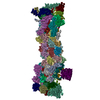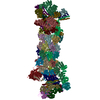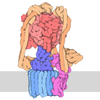[English] 日本語
 Yorodumi
Yorodumi- EMDB-2594: Deep classification of a large cryo-EM dataset defines the confor... -
+ Open data
Open data
- Basic information
Basic information
| Entry | Database: EMDB / ID: EMD-2594 | |||||||||
|---|---|---|---|---|---|---|---|---|---|---|
| Title | Deep classification of a large cryo-EM dataset defines the conformational landscape of the 26S proteasome | |||||||||
 Map data Map data | Reconstruction of 26S proteasome in low-energy state (s1) | |||||||||
 Sample Sample |
| |||||||||
 Keywords Keywords | Proteasome / AAA-ATPase / ATP-analog / classification | |||||||||
| Function / homology |  Function and homology information Function and homology informationSAGA complex localization to transcription regulatory region / Metalloprotease DUBs / peroxisome fission / proteasome storage granule assembly / transcription export complex 2 / proteasome regulatory particle assembly / protein deneddylation / nonfunctional rRNA decay / maintenance of DNA trinucleotide repeats / filamentous growth ...SAGA complex localization to transcription regulatory region / Metalloprotease DUBs / peroxisome fission / proteasome storage granule assembly / transcription export complex 2 / proteasome regulatory particle assembly / protein deneddylation / nonfunctional rRNA decay / maintenance of DNA trinucleotide repeats / filamentous growth / COP9 signalosome / proteasome regulatory particle / cytosolic proteasome complex / proteasome regulatory particle, lid subcomplex / protein-containing complex localization / proteasome-activating activity / mitochondrial fission / metal-dependent deubiquitinase activity / proteasome regulatory particle, base subcomplex / K48-linked polyubiquitin modification-dependent protein binding / proteasome core complex assembly / nuclear outer membrane-endoplasmic reticulum membrane network / Cross-presentation of soluble exogenous antigens (endosomes) / TNFR2 non-canonical NF-kB pathway / proteasomal ubiquitin-independent protein catabolic process / Ubiquitin Mediated Degradation of Phosphorylated Cdc25A / Regulation of PTEN stability and activity / KEAP1-NFE2L2 pathway / CDK-mediated phosphorylation and removal of Cdc6 / Neddylation / FBXL7 down-regulates AURKA during mitotic entry and in early mitosis / peptide catabolic process / proteasome binding / regulation of protein catabolic process / Orc1 removal from chromatin / protein deubiquitination / MAPK6/MAPK4 signaling / proteasome storage granule / Antigen processing: Ubiquitination & Proteasome degradation / endopeptidase activator activity / proteasome assembly / proteasome endopeptidase complex / proteasome core complex, beta-subunit complex / polyubiquitin modification-dependent protein binding / proteasome core complex, alpha-subunit complex / threonine-type endopeptidase activity / Ub-specific processing proteases / positive regulation of RNA polymerase II transcription preinitiation complex assembly / mRNA export from nucleus / enzyme regulator activity / ERAD pathway / protein folding chaperone / Neutrophil degranulation / proteasome complex / ubiquitin binding / nucleotide-excision repair / positive regulation of transcription elongation by RNA polymerase II / double-strand break repair via homologous recombination / positive regulation of protein catabolic process / metallopeptidase activity / protein-macromolecule adaptor activity / ubiquitin-dependent protein catabolic process / proteasome-mediated ubiquitin-dependent protein catabolic process / endopeptidase activity / ubiquitinyl hydrolase 1 / cysteine-type deubiquitinase activity / molecular adaptor activity / regulation of cell cycle / chromatin remodeling / protein domain specific binding / mRNA binding / ubiquitin protein ligase binding / endoplasmic reticulum membrane / structural molecule activity / endoplasmic reticulum / ATP hydrolysis activity / positive regulation of transcription by RNA polymerase II / mitochondrion / ATP binding / identical protein binding / nucleus / metal ion binding / cytoplasm / cytosol Similarity search - Function | |||||||||
| Biological species |  | |||||||||
| Method | single particle reconstruction / cryo EM / Resolution: 7.7 Å | |||||||||
 Authors Authors | Unverdorben P / Beck F / Sledz P / Schweitzer A / Pfeifer G / Plitzko JM / Baumeister W / Foerster F | |||||||||
 Citation Citation |  Journal: Proc Natl Acad Sci U S A / Year: 2014 Journal: Proc Natl Acad Sci U S A / Year: 2014Title: Deep classification of a large cryo-EM dataset defines the conformational landscape of the 26S proteasome. Authors: Pia Unverdorben / Florian Beck / Paweł Śledź / Andreas Schweitzer / Günter Pfeifer / Jürgen M Plitzko / Wolfgang Baumeister / Friedrich Förster /  Abstract: The 26S proteasome is a 2.5 MDa molecular machine that executes the degradation of substrates of the ubiquitin-proteasome pathway. The molecular architecture of the 26S proteasome was recently ...The 26S proteasome is a 2.5 MDa molecular machine that executes the degradation of substrates of the ubiquitin-proteasome pathway. The molecular architecture of the 26S proteasome was recently established by cryo-EM approaches. For a detailed understanding of the sequence of events from the initial binding of polyubiquitylated substrates to the translocation into the proteolytic core complex, it is necessary to move beyond static structures and characterize the conformational landscape of the 26S proteasome. To this end we have subjected a large cryo-EM dataset acquired in the presence of ATP and ATP-γS to a deep classification procedure, which deconvolutes coexisting conformational states. Highly variable regions, such as the density assigned to the largest subunit, Rpn1, are now well resolved and rendered interpretable. Our analysis reveals the existence of three major conformations: in addition to the previously described ATP-hydrolyzing (ATPh) and ATP-γS conformations, an intermediate state has been found. Its AAA-ATPase module adopts essentially the same topology that is observed in the ATPh conformation, whereas the lid is more similar to the ATP-γS bound state. Based on the conformational ensemble of the 26S proteasome in solution, we propose a mechanistic model for substrate recognition, commitment, deubiquitylation, and translocation into the core particle. | |||||||||
| History |
|
- Structure visualization
Structure visualization
| Movie |
 Movie viewer Movie viewer |
|---|---|
| Structure viewer | EM map:  SurfView SurfView Molmil Molmil Jmol/JSmol Jmol/JSmol |
| Supplemental images |
- Downloads & links
Downloads & links
-EMDB archive
| Map data |  emd_2594.map.gz emd_2594.map.gz | 78.5 MB |  EMDB map data format EMDB map data format | |
|---|---|---|---|---|
| Header (meta data) |  emd-2594-v30.xml emd-2594-v30.xml emd-2594.xml emd-2594.xml | 8.8 KB 8.8 KB | Display Display |  EMDB header EMDB header |
| Images |  emd_2594.jpg emd_2594.jpg | 182.3 KB | ||
| Archive directory |  http://ftp.pdbj.org/pub/emdb/structures/EMD-2594 http://ftp.pdbj.org/pub/emdb/structures/EMD-2594 ftp://ftp.pdbj.org/pub/emdb/structures/EMD-2594 ftp://ftp.pdbj.org/pub/emdb/structures/EMD-2594 | HTTPS FTP |
-Validation report
| Summary document |  emd_2594_validation.pdf.gz emd_2594_validation.pdf.gz | 218.3 KB | Display |  EMDB validaton report EMDB validaton report |
|---|---|---|---|---|
| Full document |  emd_2594_full_validation.pdf.gz emd_2594_full_validation.pdf.gz | 217.4 KB | Display | |
| Data in XML |  emd_2594_validation.xml.gz emd_2594_validation.xml.gz | 6.3 KB | Display | |
| Arichive directory |  https://ftp.pdbj.org/pub/emdb/validation_reports/EMD-2594 https://ftp.pdbj.org/pub/emdb/validation_reports/EMD-2594 ftp://ftp.pdbj.org/pub/emdb/validation_reports/EMD-2594 ftp://ftp.pdbj.org/pub/emdb/validation_reports/EMD-2594 | HTTPS FTP |
-Related structure data
| Related structure data |  4cr2MC  2595C  2596C  4cr3C  4cr4C M: atomic model generated by this map C: citing same article ( |
|---|---|
| Similar structure data |
- Links
Links
| EMDB pages |  EMDB (EBI/PDBe) / EMDB (EBI/PDBe) /  EMDataResource EMDataResource |
|---|---|
| Related items in Molecule of the Month |
- Map
Map
| File |  Download / File: emd_2594.map.gz / Format: CCP4 / Size: 81.8 MB / Type: IMAGE STORED AS FLOATING POINT NUMBER (4 BYTES) Download / File: emd_2594.map.gz / Format: CCP4 / Size: 81.8 MB / Type: IMAGE STORED AS FLOATING POINT NUMBER (4 BYTES) | ||||||||||||||||||||||||||||||||||||||||||||||||||||||||||||||||||||
|---|---|---|---|---|---|---|---|---|---|---|---|---|---|---|---|---|---|---|---|---|---|---|---|---|---|---|---|---|---|---|---|---|---|---|---|---|---|---|---|---|---|---|---|---|---|---|---|---|---|---|---|---|---|---|---|---|---|---|---|---|---|---|---|---|---|---|---|---|---|
| Annotation | Reconstruction of 26S proteasome in low-energy state (s1) | ||||||||||||||||||||||||||||||||||||||||||||||||||||||||||||||||||||
| Voxel size | X=Y=Z: 1.99 Å | ||||||||||||||||||||||||||||||||||||||||||||||||||||||||||||||||||||
| Density |
| ||||||||||||||||||||||||||||||||||||||||||||||||||||||||||||||||||||
| Symmetry | Space group: 1 | ||||||||||||||||||||||||||||||||||||||||||||||||||||||||||||||||||||
| Details | EMDB XML:
CCP4 map header:
| ||||||||||||||||||||||||||||||||||||||||||||||||||||||||||||||||||||
-Supplemental data
- Sample components
Sample components
-Entire : 26S Proteasome from Saccharomyces cerevisiae
| Entire | Name: 26S Proteasome from Saccharomyces cerevisiae |
|---|---|
| Components |
|
-Supramolecule #1000: 26S Proteasome from Saccharomyces cerevisiae
| Supramolecule | Name: 26S Proteasome from Saccharomyces cerevisiae / type: sample / ID: 1000 / Number unique components: 1 |
|---|---|
| Molecular weight | Experimental: 2.5 MDa / Theoretical: 2.5 MDa |
-Macromolecule #1: 26S Proteasome
| Macromolecule | Name: 26S Proteasome / type: protein_or_peptide / ID: 1 / Recombinant expression: No |
|---|---|
| Source (natural) | Organism:  |
| Molecular weight | Experimental: 2.5 MDa / Theoretical: 2.5 MDa |
-Experimental details
-Structure determination
| Method | cryo EM |
|---|---|
 Processing Processing | single particle reconstruction |
| Aggregation state | particle |
- Sample preparation
Sample preparation
| Concentration | 0.3 mg/mL |
|---|---|
| Vitrification | Cryogen name: ETHANE / Instrument: OTHER |
- Electron microscopy
Electron microscopy
| Microscope | FEI TITAN KRIOS |
|---|---|
| Alignment procedure | Legacy - Electron beam tilt params: 0 |
| Date | Dec 24, 2013 |
| Image recording | Category: CCD / Film or detector model: TVIPS TEMCAM-F816 (8k x 8k) / Number real images: 30000 / Average electron dose: 25 e/Å2 / Bits/pixel: 14 |
| Tilt angle min | 0 |
| Tilt angle max | 0 |
| Electron beam | Acceleration voltage: 200 kV / Electron source:  FIELD EMISSION GUN FIELD EMISSION GUN |
| Electron optics | Illumination mode: FLOOD BEAM / Imaging mode: BRIGHT FIELD / Cs: 2 mm / Nominal defocus max: 3.5 µm / Nominal defocus min: 1.0 µm |
| Sample stage | Specimen holder model: FEI TITAN KRIOS AUTOGRID HOLDER |
| Experimental equipment |  Model: Titan Krios / Image courtesy: FEI Company |
- Image processing
Image processing
| Details | The particles were selected using an automatic selection program. Each physical 26S particles was considered as two particles for processing according to pseudo-C2 symmetry. |
|---|---|
| CTF correction | Details: micrograph |
| Final reconstruction | Applied symmetry - Point group: C1 (asymmetric) / Algorithm: OTHER / Resolution.type: BY AUTHOR / Resolution: 7.7 Å / Resolution method: FSC 0.143 CUT-OFF / Software - Name: xmipp / Number images used: 1300000 |
 Movie
Movie Controller
Controller
































